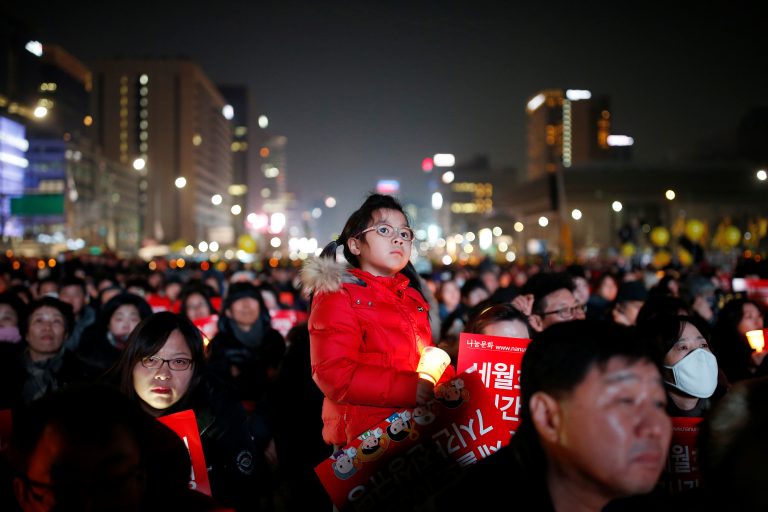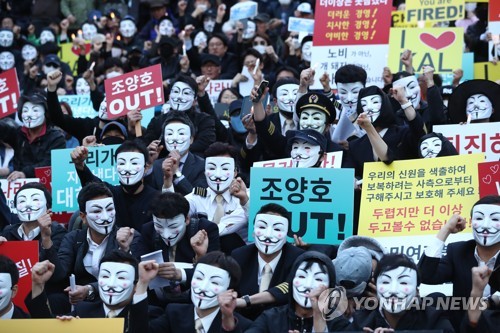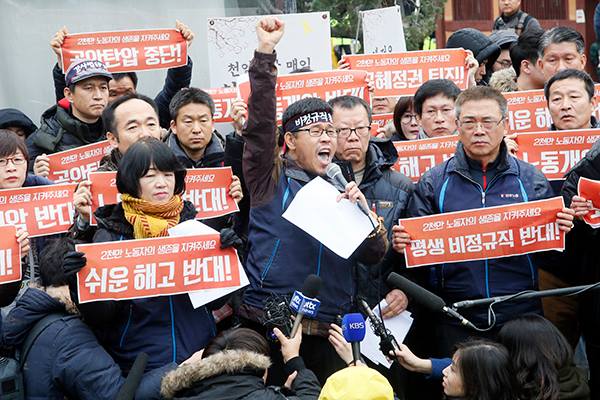Song Ho-joon
May 4, 2018
In November 2016 candlelight vigils began to flare up in South Korea. Millions of people joined the movement and within a couple of months they succeeded in ousting the ultra-right wing Park Geun-hye administration. The advent of the Moon Jae-in liberal government created a new political environment in which gaining some reforms within the system seemed to be possible. This new milieu generated a concern among labor activists about how they had to carry out their revolutionary goals. Applying a theory about reform and revolution to reality in a concrete way is not an easy task, unless one simply believes that any action to obtain a reform is wrong and the labor movement thus must work only for a radical solution.
The reappearance of the controversy between “reform” and “revolution”

Candlelight protest, South Korea, Fall 2016
Although capitalism’s fundamental contradictions that stem from its socially created but privately owned production processes have variously manifested themselves in different times and spaces, every capitalist society witnessed the emergence of workers’ struggles not only for their livelihood but also for their liberation from the capitalist system itself. But when working-class hegemony got weaker and when socialism seemed not to be able to become an alternative to capitalism, there had appeared a tendency among workers that they should gain some material benefits within the system, rather than fight for fundamental systemic changes. The tendency appeared more in advanced capitalist societies where the accumulation of capital made it possible for some material gains to relatively easily trickle down to the workers. Many workers in advanced capitalist countries thus may seem to think that the goal of the labor movement is to expand reforms within the system.
However, in Third World countries where capitalist accumulation was not large enough to offer some material benefits to the working class, workers’ demands for even a limited range of reforms were brutally repressed. Like in many other Third World countries, capitalism in Korea developed rapidly and both capital and the state ruthlessly suppressed either reformist or revolutionary labor revolts. Moreover, since the Korean War and the division of the nation, the state and capital used anti-communist ideologies as a strong weapon to put down workers’ movements. Furthermore, in the late 1980s the labor movement revived its revolutionary tradition and spirit, took a leading role in the liberation movement of the oppressed people, and developed more militant and radical strategies than its counterparts in many other countries. Admittedly, a tendency to settle within the system grew stronger, as capitalism advanced further. Nevertheless, social structural changes have remained as a goal for many labor activists, regardless of how differently they defined the path to revolution.
The limitation of Moon Jae-in’s liberal reform policies

Korean Air Lines Protests 2018
Although candlelight vigils were triggered by the disclosure of the ultra-right wing government’s corruption, depravity, and violation of democracy and human rights, the revolt was fundamentally grounded upon the grievances of people whose lives were destroyed and who had been driven to the edge by neo-liberal policies for the past twenty years. Whereas an extremely small number of people at the top had accumulated wealth, a majority of people had suffered from poverty, an expansion of precarious and irregular jobs and contracting-out systems, and the deepening of chronic economic recession and crises. These realities, accompanied by the corruption of the Park administration, caused an explosion of the people’s anger, which was expressed in the vigils.
The Moon administration, which owes its successful seizure of power to people’s struggles, styled itself as a “vigil government” and proclaimed that it would make reforms to live up to people’s demands and expectations. It has penalized those who participated in the Park administration’s corruption and restored some of the democratic mechanisms in society as well as inside the government. It began to make an effort to improve its relationship with the North Korean government in order to ease military tensions. Its policies that could advance people’s lives, such as regularization of public sector jobs, increase in minimum wages and social welfare, and stabilization of the real estate market, got public support. Nevertheless, as time went by, the limitation of the Moon Jae-in administration, whose philosophy is based on liberalism, became clear.
Turning regular jobs into irregular ones by changing pay from salaries to wages and eliminating benefits or by hiring contracted-out workers had been one of the responses by capital and the state to the 1997-98 financial crisis and to the ensuing pressure from the IMF to restructure the Korean political economy. By 2005 irregular workers constituted more than 50 percent of the workforce in Korea. During the last twenty years, their precarious working and employment conditions had created one of the most egregious economic and social problems and had been a focal point that the labor movement tried to challenge. Even some liberals began to argue that converting the irregular workforce to regular work would be one effective strategy for overcoming the economy’s problems. Because of pressure from the labor movement but also because Moon Jae-in was in line with these liberals, the current administration announced that it would begin switching irregulars workers to regular work in the public sector.
In regard to the public sector in Korea, companies in the infrastructure industry, such as electricity, communication, and transportation, had been owned or operated by the state since soon after the birth of the republic in order to promote a rapid development of capitalism. Since the late 1990s when the IMF forced it to restructure the political economy, the government has attempted to privatize these companies. However, due to several complex factors, including fierce resistance from the labor movement against privatization, a lot of these companies remain publicly owned and have an impact on the nation’s economy. Policies regulating companies in the public sector have tended to be expanded to companies in the private sector. Therefore, a plan to promote the regularization of irregular jobs in the public sector could be an important step toward economic recovery.
However, the hollowness of Moon’s plan was soon revealed when the government allowed public sector companies to use various ways to avoid regularization of their workers. For example, instead of directly rehiring their existing irregular or contracted-out workers, companies created subsidiary companies and rehired them in the latter. Although hired as regulars these workers could be paid less and forced to work in worse conditions than their counterparts in the parent company. Moreover, even when companies directly hired workers as regulars, they classified them differently from existing regulars. By doing so, companies could avoid paying them as much as regulars and maintain unequal treatment among workers. The government’s policy not only failed to eliminate discrepancies between regular and irregular workforces but created new inequalities within the working class and thus generated tension and competition among workers.
How companies dealt with people’s demand for a $10 per hour minimum wage is another example of the limitations of the government’s reform policies. Moon raised the minimum wage by a larger percentage than previous administrations and announced his plan to increase the minimum wage each year until it reaches $10 by year 2020. However, capital responded by using various methods to contain or reduce real wages or by firing workers in large numbers. For instance, one company used wage increases as a pretext to fire its workers and then contracted out the work or mechanized the tasks. Some others began to include food expenses or holiday bonuses in calculating wages, which had previously been excluded. Other companies reduced official work hours by giving workers more break times, although workers did not or could not actually use the breaks. Some companies forced their workers to take their vacation times, while requiring them to finish their tasks within the reduced work hours.

Han Sang-gyun, jailed president of the Korean Confederation of Trade Unions (KCTU)
KCTU photo
Although the administration declared that it would break with past practices and expand democracy throughout society, those who had been imprisoned as a result of their fierce struggles against the corrupt government, as well as prisoners of conscience, still remain behind bars. For example, Moon hasn’t released Han Sang-gyun, who is the president of the Korean Confederation of Trade Unions, and who has been in jail for years for his labor activism. The national security laws suppressing civil liberties have no prospect to be reformed and the Korean Government Employees’ Union and the Korean Teachers and Education Workers Union are still prevented from enjoying their legal right to form a union. Over the past several years, hundreds of mail delivery workers in the Woo-jung post office have been killed by their excessively long work hours. Surviving workers and family members are still fighting to obtain justice and fair work conditions by occupying the street, living in tents, protesting in elevated places, such as on factory roofs, steel towers, and billboards, and organizing hunger strikes. Workers in the GM factory in Gun-san were recently locked out due to its closing, and Kumho Tires workers are currently facing a large-scale lay-off because the company was forced to restructure itself before its sale.
The administration stated that it would forge peace with the North Korean government by reducing military tensions. However, it pushed ahead the U.S. government’s additional THAAD (Terminal High Altitude Area Defense) placement on Korean soil — an action that intensified the military confrontation and put all people on the Korean peninsula in danger. The relationship between the North and South Korean governments began to thaw slightly when they exchanged special envoys and communicated with each other to form joint teams for the 2018 Winter Olympics. Since then, the South Korean government has seemed to be exercising its voice in its relationship with the North. However, it is doubtful that the Moon administration’s position will move away from the U.S.-centered strategy, according to which the United States and her allies maintain nuclear weapons, while suppressing by any means possible the possession of nuclear weapons by Third World countries that are not under the U.S. military umbrella. The U.S. government still holds the ultimate power to create long-term peaceful conditions on the peninsula. The Moon government, as a junior partner of the United States, shares Trump’s view.
“Déjà vu” of the Kim and Roh liberal reform administrations in the early 21st century
Forgetting past experiences and lessons is one of the reasons a social movement fails. Before Moon’s ascendancy, Korean workers had already experienced liberal governments’ inconsistencies in their reform efforts as well as their betrayal of the people’s will. When masses of Koreans overthrew military rule in 1987, when they elected Kim Dae-jung in 1998 as president, hoping that his administration would fight the late 1990s’ financial crisis for their benefit, and when in 2003 they put in power Roh Moo-hyun who had had a long relationship with the labor movement, their expectations and hopes turned into disappointment not long after.
President Kim and President Roh (in leadership from 1998-2007), like Moon today, owed their rise to power to people’s struggles for democracy. During the initial period, they carried out some policies that were auspicious for the oppressed: They reinstated those who had been punished by the state and those who had been fired while fighting for workers’ rights. As a result, people’s expectations for and illusions about the government grew. Many labor union officers believed that the labor movement should change its direction toward cooperating with the government and gaining material benefits as a result. They retreated from organizing militant struggles. Some even decided to work within the government by abandoning the belief that political independence was necessary for the labor movement.
However, the Kim-Roh administrations began to reveal their true identities when an increasing number of workers in individual workplaces fought for their rights. At first, the government acted as a mediator, but as time passed, it often sided with capital (or acted as capital in the public sector). The administrations were thoroughly won over by neo-liberalism and rapidly and openly showed their anti-labor stance. It was during this period that the irregular workforce was enormously expanded.
Moon stated that this time would be different. What should be our current attitude toward the Moon administration that has been promising a wide range of reforms? Should we rely on him for social reforms or reject all reforms by asserting that any expanded democratic spaces within the system have limitations?
The praxis of the South Korean labor movement toward a fundamental social change
During the Kim-Roh era, many union officers retreated from organizing a fight and cooperated with the government; however, irregular workers began to organize militant and historic struggles, in fact, leading the labor movement. This experience showed that having a liberal and seemingly reform-minded government was not necessarily beneficial to people at the bottom and that the labor movement needed to continue to fight to improve workers’ working and living conditions on their own without relying on the government. And as examined above, Moon’s reform policies so far have not satisfied people’s demands pouring out like a stream from a broken dam.
The labor movement thus needs to move beyond the liberals’ limitation. It should go beyond criticizing the administration’s reform policies as deceptive and develop its own political capabilities to expand reforms that can advance class struggles. In the process, the labor movement ought to strengthen political independence and assume a leading role in the Korean progressive movement. It must fight to gain substantive reforms and expand real democracy through its own struggles.
In order to do this, we need to recognize the power of workers who constitute an overwhelming majority of Korean people. We are already witnessing conflicts and tensions widening the gap between Moon Jae-in, who attempts to limit the achievement of the candlelight-vigil revolution within the framework of liberal reform, and workers, who struggle to expand the revolution into social structural changes.
Song, Ho-joon, is a railway worker who has participated in the Korean labor movement and railway workers’ organizing struggles for the last three decades. He has been imprisoned twice due to his involvement in railway workers’ strikes. In 2015, the union members of KCTU Seoul Region elected him as General Secretary of the Korean Confederation of Trade Unions (KCTU) Seoul Regional Council. After his two-year term was over, he went back to his workplace in 2017 where his job is to maintain and repair facilities and train cars.
